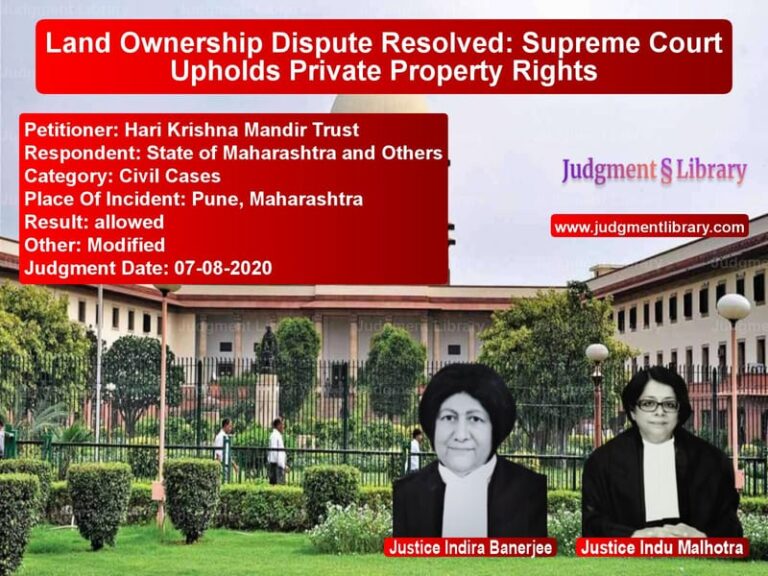Supreme Court Ruling on Section 319 CrPC: Acquittal in Haryana Rape and Murder Case
The case of Naveen vs. State of Haryana & Others deals with a criminal appeal challenging the summoning of the appellant as an accused in a rape and murder case. The Supreme Court was tasked with determining whether there was sufficient evidence to invoke Section 319 of the Code of Criminal Procedure (CrPC) to summon the appellant for trial alongside the main accused.
Background of the Case
The case stems from an incident on March 10, 2018, when a 20-year-old woman from Bhiwani, Haryana, went missing after leaving for her coaching center. Later that day, she was found in an unconscious state and admitted to Sunflag Hospital, Rohtak. The victim succumbed to her injuries on March 13, 2018, and the police added Section 302 IPC to the charges.
Initially, the police investigation found evidence against the main accused, Arjun, while two others, including Naveen (the appellant) and another person, were declared innocent. However, the complainant (the victim’s mother) later sought to summon them under Section 319 CrPC.
Key Legal Issues
- Whether the evidence presented in court met the threshold required for invoking Section 319 CrPC.
- Whether the trial court was correct in rejecting the complainant’s application for summoning the appellant.
- Whether the High Court of Punjab and Haryana erred in reversing the trial court’s decision.
- Whether mere presence at a hospital can establish criminal complicity.
Arguments by the Petitioner (Naveen)
The appellant, through his counsel, argued:
- The police investigation had already exonerated him, and no fresh evidence justified summoning him.
- His mere presence at the hospital did not make him an accomplice to the crime.
- Witnesses, including the hotel manager and a waiter, testified that the victim voluntarily accompanied Arjun to the hotel where the crime allegedly occurred.
- The trial court correctly rejected the application, as the complainant’s statements were inconsistent.
Arguments by the Respondent (State of Haryana & Complainant)
The complainant and prosecution countered:
- The complainant had initially named Naveen as an accomplice in her FIR, but the police failed to charge him.
- CCTV footage from Sunflag Hospital confirmed that Naveen was present when the victim was admitted.
- The complainant deposed in court, reiterating that Naveen played a role in the crime.
- The High Court had correctly observed that new evidence had emerged, warranting his summoning.
Supreme Court’s Observations
The Supreme Court relied on its Constitution Bench ruling in Hardeep Singh vs. State of Punjab, which clarified the test for invoking Section 319 CrPC:
“The power under Section 319 CrPC is discretionary and extraordinary, to be exercised sparingly. It is not to be used merely because the magistrate or sessions judge suspects someone might be guilty. The evidence must be strong and cogent.”
Examining the evidence, the Court found:
- The victim was last seen with Arjun, the main accused.
- The CCTV footage did not show Naveen at the hotel where the crime allegedly took place.
- There was no direct evidence linking Naveen to the crime beyond his presence at the hospital.
Consequently, the Court ruled:
“The evidence, even if unrebutted, would not lead to the conviction of the appellant. The High Court’s order summoning him is not sustainable in law.”
Judgment Outcome
The Supreme Court set aside the Punjab and Haryana High Court’s order and ruled that Naveen should not be summoned as an accused under Section 319 CrPC.
Key Takeaways from the Judgment
- Courts should not invoke Section 319 CrPC unless there is strong and cogent evidence.
- Mere suspicion or circumstantial presence does not justify summoning an individual as an accused.
- Trial courts have the discretion to reject applications under Section 319 if they do not meet the required evidentiary threshold.
- The ruling reaffirms the principle that an accused should not be tried unless there is sufficient legal evidence.
Conclusion
The Supreme Court’s decision in this case reinforces the high evidentiary threshold required for summoning an individual under Section 319 CrPC. It ensures that individuals are not arbitrarily dragged into criminal trials based on weak or circumstantial evidence. This ruling sets a strong precedent for future cases where additional accused are sought to be summoned based on fresh evidence.
Petitioner Name: Naveen.Respondent Name: State of Haryana & Others.Judgment By: Justice Ajay Rastogi, Justice C.T. Ravikumar.Place Of Incident: Bhiwani, Haryana.Judgment Date: 31-10-2022.
Don’t miss out on the full details! Download the complete judgment in PDF format below and gain valuable insights instantly!
Download Judgment: naveen-vs-state-of-haryana-&-o-supreme-court-of-india-judgment-dated-31-10-2022.pdf
Directly Download Judgment: Directly download this Judgment
See all petitions in Bail and Anticipatory Bail
See all petitions in Custodial Deaths and Police Misconduct
See all petitions in Attempt to Murder Cases
See all petitions in Judgment by Ajay Rastogi
See all petitions in Judgment by C.T. Ravikumar
See all petitions in allowed
See all petitions in Quashed
See all petitions in supreme court of India judgments October 2022
See all petitions in 2022 judgments
See all posts in Criminal Cases Category
See all allowed petitions in Criminal Cases Category
See all Dismissed petitions in Criminal Cases Category
See all partially allowed petitions in Criminal Cases Category







